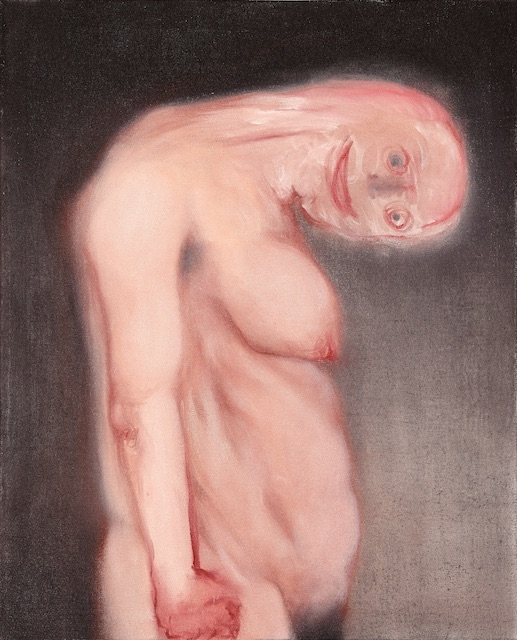Ambiguously positioned between pleasure and pain, perpetrator and victim, numerous figures in extremis feature in Miriam Cahn’s first retrospective in Poland, I As Human. Taken from Cahn’s automatic writings, this statement confuses the subject/object, and the idea that everyone or thing, to allude to a specific work’s title, couldbeme. In this 2017 work the Swiss artist paints a veiled woman and child in a gridded, barren landscape appearing to flee as two men advance gripping their penises, or the bloody place where one once was.
A sense of peril extends beyond the obviously ‘human’. In a frenzy of chalk, megalopolis (1987) peers down on a modern cityscape, teeming with phallic architecture. classic(al) loving (état de guerre / state of war) (1983) comprises ten quickfire abstract drawings horizontally applied to the wall, evoking a filmstrip, and expresses Cahn’s experience of harassment on a train. Featuring hanging breasts and an apelike face, mammal (1998) is a more subtly volatile work, exemplifying how Cahn, as she’s said, ‘dissolve[s] the oilpaintingness, just as previously I dissolved the so-called drawing-ness through the sheer size and quantity’. Its gaseous surface speaks to the slippery spectrum upon which mammals (a word that has its origin in ‘of the breast’) are ascribed subjectivity.
Born in 1949 to Jewish immigrants fleeing Nazi persecution, Cahn became a peace-movement activist and a feminist, notably withdrawing her work from Documenta 7 in 1982 following what she purportedly considered unfair treatment by director Rudi Fuchs. (She made a celebrated return in 2017’s 14th edition.) Cahn’s history is often evoked to elucidate her ‘radical empathy’ (to quote a term used by the exhibition’s public programme curator Natalia Sielewicz), and as ‘a document of my helplessness’ (in Cahn’s words), her work is an undoubtedly sincere interrogation of the ever-emmeshed personal and political. But how does it play to an audience increasingly desensitised to violent imagery, yet sensitised to more oblique structural violence and privilege?
decay (2017) might be a self-portrait, and depicts a white female figure grimacing at us, with cartoonish red-rimmed eyes, bald head bent forward at a cruel right angle, a fist clenched. In blackwomanwarrior (2018) a black woman’s face is further abstracted in the modernist ‘primitive’ style, and the genitals are notably exaggerated. The argument that Cahn schematises all bodies through varying degrees of abstraction doesn’t prevent me reading this painting as another manifestation of the crass, violating tropes that white spectators have historically inflicted on black bodies, regardless of other intersectional experience.
In the cavernous white cube of the Museum of Modern Art’s temporary pavilion, I feel coerced into this sense of unilaterality by Cahn’s self-directed hang. Eschewing any division of the space, the nonchronological, salon-style presentation, which includes sculpture and digital media, feels conceptually heavy-handed in its choruslike approach. A series of 31 colour-treated scans, including Second World War aerial photographs of concentration camps, comprise processing (2019). It strikes a particularly bum note as I squint up at the images set high above other works, these harrowingly real apertures into mass annihilation reduced to motifs, even if that was the point. I am drawn back to the more liminal paintings and drawings, notably the radioactive emptiness of the blue house (1992) in pigment and charcoal, a vast tonal chalk drawing of a bed (1981), appearing mundane yet aggressive and isolated, and geology (2017), a panorama in oils of the Swiss mountains as viewed from Cahn’s window, thrumming with Douglas Sirkian drama and portent. Suggesting something queer in the quotidian, these works become portals through which disquieting associations might channel, and ferment in the manner of her ‘dissolving’ surfaces. Here, I feel something akin to empathy.
Miriam Cahn, I As Human, Museum of Modern Art, Warsaw, 29 November 2019 – 1 March 2020
From the March 2020 issue of Artreview
